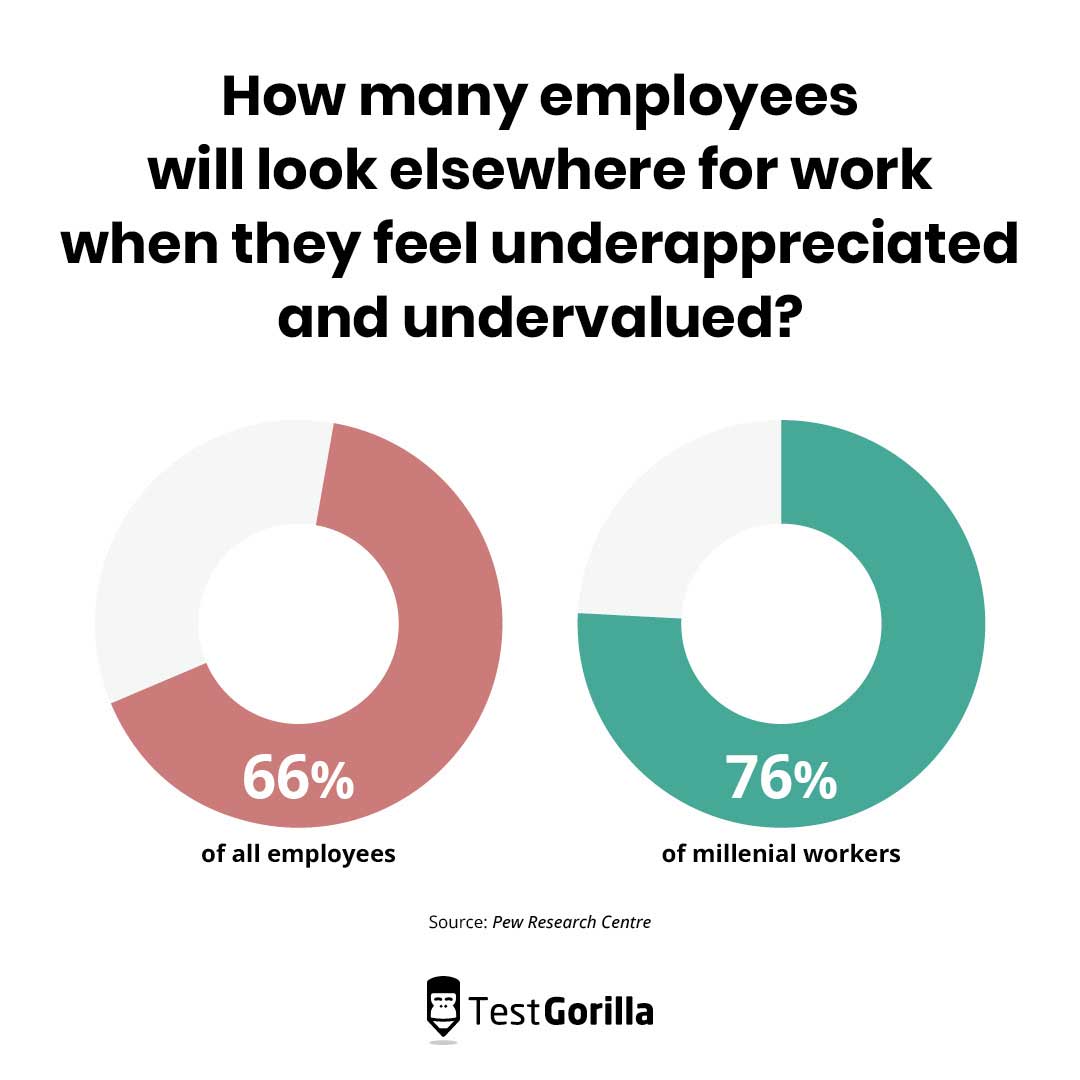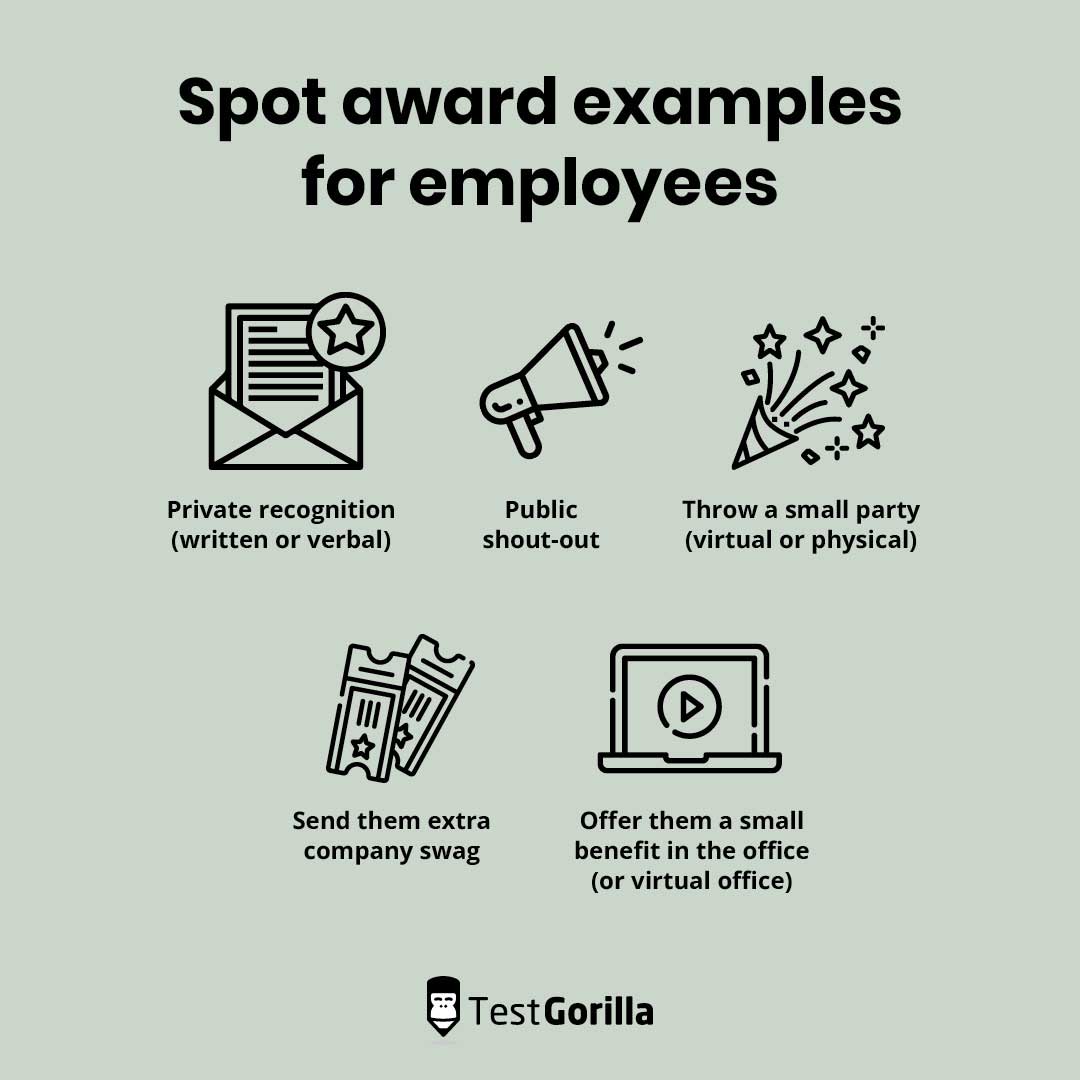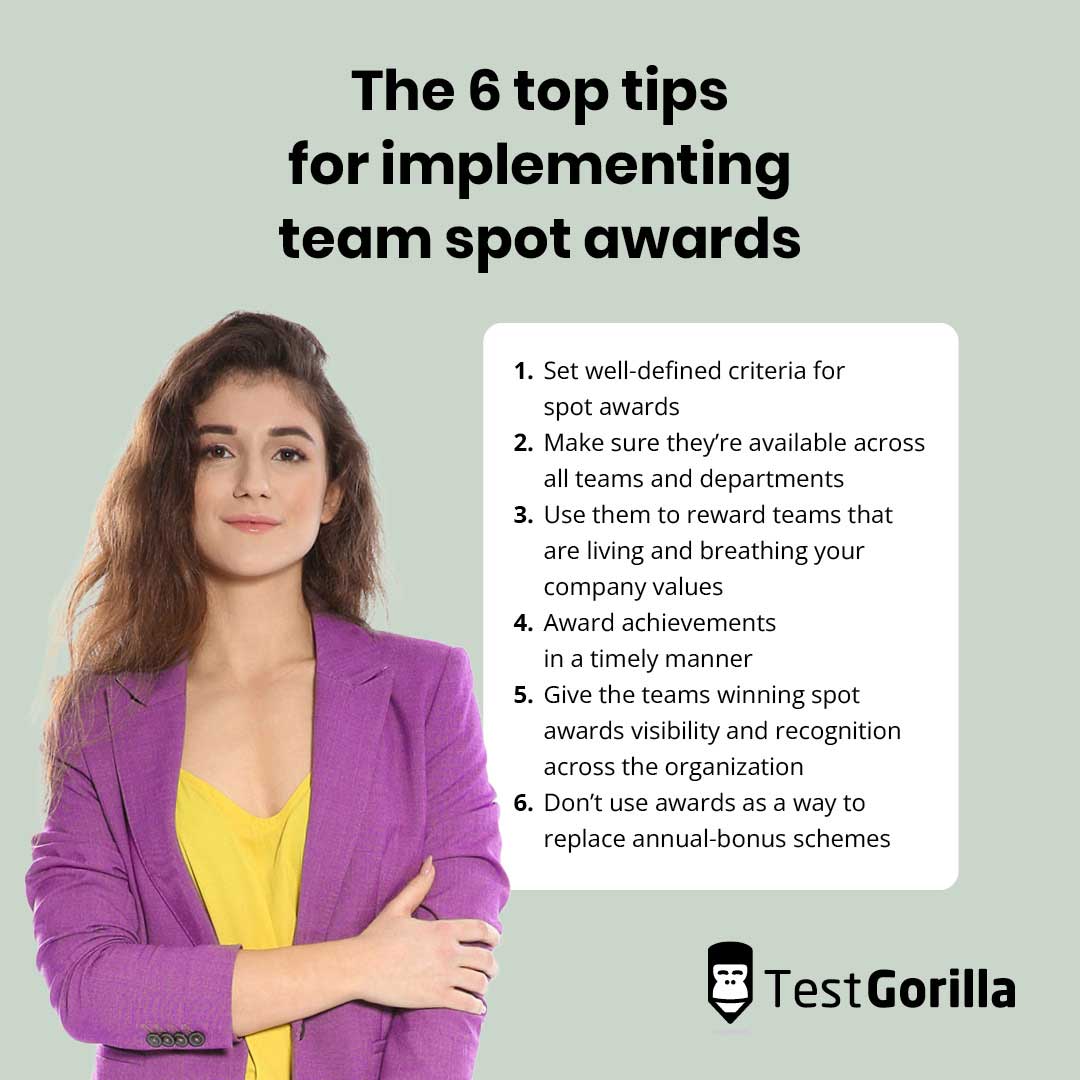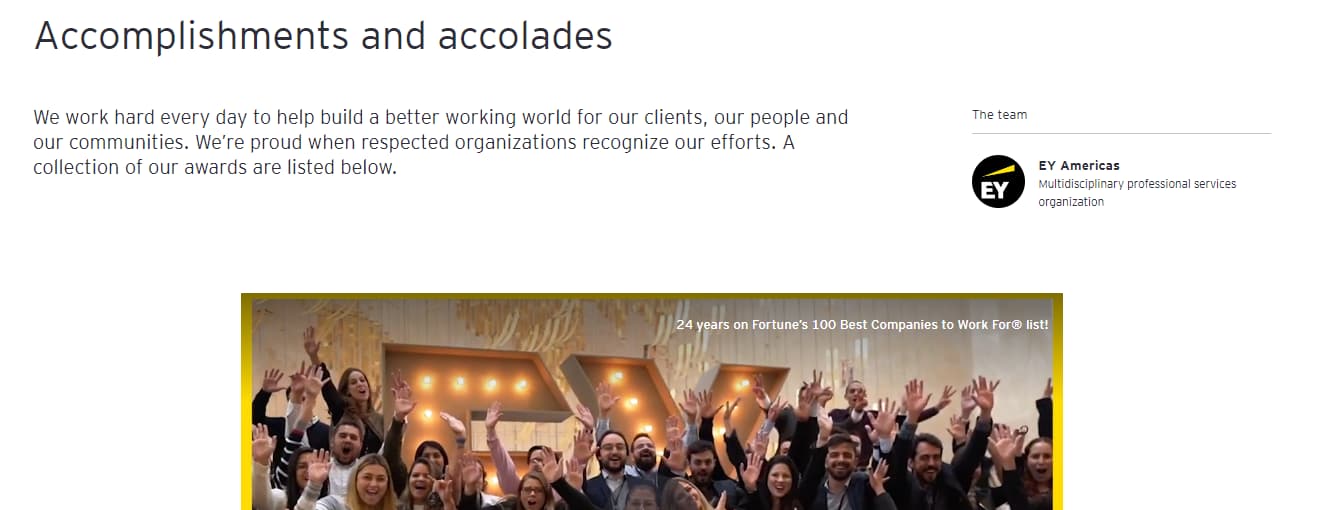How to use spot awards to recognize and motivate employees
Spot-award programs are gaining popularity as the new face of employee recognition. They aim to replace old systems like “employee of the month,” but most are the same thing under a new name.
Many spot-award programs come with a number of challenges like exclusivity, favoritism, and feeling artificial or forced.
So, should you abandon spot awards and recognition schemes altogether?
No. Instead, you should change how you use spot awards to favor balance and inclusivity.
Spot awards boost employee motivation, retention, and engagement when used correctly. They can also be a healthy part of your company culture.
This article highlights the benefits and drawbacks of spot-award programs and the top strategies for implementing one the right way. We also discuss TestGorilla’s perspective on spot awards and how we believe they should be handled.
What is a spot award?
A spot award is a small prize, monetary or non-monetary, that immediately recognizes the achievement and performance of teams or individual employees.
Here’s a quick example:
Derrick worked extra hours on a big project after another employee dropped out due to an emergency. After the team completed the project and met the deadline, thanks to Derrick, his manager gave him a public shout-out on LinkedIn.
Decades of research have shown that awards enhance employees’ commitment to goals, their motivation to reach them, and the belief in themselves that they can achieve future objectives.
The benefits of spot awards
Appreciating employees with spot recognition brings a wealth of benefits, so let’s take a closer look at them.
Benefit | Description |
Increase employee satisfaction | Having their work recognized increases an employee’s overall job satisfaction |
Promote good behaviors and motivation | By reinforcing exceptional performance with awards, you’re encouraging positive behavior in the future |
Improve team performance | Bringing a team together with group spot awards improves morale and collaboration |
Make employees feel appreciated | Awarding spot recognition makes workers feel appreciated, boosting retention |
Increase employee satisfaction
Recognizing and awarding a job well-done increases how satisfied an employee is with their effort, projects, and job role.
Harvard Business Review says that spot bonuses, praise, and recognition help raise employees’ overall satisfaction.
HBR cites a study that ties this satisfaction directly to monetary benefits, but simple appreciation is just as desired.[1]
Research shows that recognition drives employee engagement and hard work more than learning and development, promotions, and higher pay.
The satisfaction of an employee increases when they know that their leaders notice the effort they put in, so it isn’t a surprise that great senior leadership is one of the top job-satisfaction factors for today’s workers.
Promote good behaviors and motivation
Spot recognition fosters positive habits, behaviors, and skills, essentially motivating employees to use their talents more often.
This happens in two ways:
On a conscious level:
An employee is rewarded for something they did, so they now know how important it is
On an unconscious level:
The brain is more likely to promote behaviors into habits and associate good feelings with them when rewarded.[2]
Really, it boils down to communication. How will your employees know their effort is important if you don’t tell them explicitly?
Improves team performance
Team spot awards are great for encouraging collaboration and coordination in a group. They show employees that their combined talents and hard work lead to success.
Individual spot awards are typical, but attributing awards for team performance can foster healthy relationships, bolster team morale, and encourage further teamwork.
It can be disheartening when only one or two members get an award, but when the entire group is recognized for the part they played, it brings them closer and creates a stronger team for future projects.
Makes employees feel appreciated
Does it seem obvious? Of course, spot awards make employees feel appreciated!
But let’s look more closely. A feeling of appreciation can have surprisingly far-reaching benefits.
Appreciation is one of the top driving forces behind high employee retention. One study showed that 66% of all employees would quit if they felt unappreciated.[3]
The study also showed that 76% of millennials would quit if they felt unappreciated, and millennials encompass 35% of the workforce.
However, only 54% of senior managers feel that staff quit due to a lack of appreciation, showing a gap between how senior leadership views the importance of recognition.
The best insights on HR and recruitment, delivered to your inbox.
Biweekly updates. No spam. Unsubscribe any time.
The drawbacks of spot awards
The disadvantages of spot awards are mainly the result of poorly executed employee spot-award programs.
Let’s examine the drawbacks to see how you can avoid them and build a reward program that shines.
Drawback | Description |
There’s a risk of rewarding only particularly high-performing team members | High performers deserve recognition, but recognizing small victories of low performers can be a much-needed morale boost |
Managers’ efforts might go unrewarded or overlooked | Managers can be left out of receiving awards because they’re often the ones to give them out |
Can create tension in teams if they’re perceived to be awarded unfairly | Teams can struggle with morale and collaboration if certain members get more attention, especially if others feels that this is unjust |
There’s a risk of rewarding only particularly high-performing team members
High-performers sometimes make up only the top 5% of staff, and spot awards generally focus on them.
What about the other 95% contributing to your company’s success?
If you don’t take care to look at the achievements and performance of every employee, spot-award programs can feel exclusive and unfair.
The best way to avoid this is to set well-defined criteria for receiving a spot award and make them inclusive to every employee.
Managers’ efforts might go overlooked and unrewarded
Managers often give out awards and handle the spot-award programs – so who rewards them?
Leaders have so much on their plates and are just as hard-working as the employees they manage. So, it can be demoralizing to give out recognition and not receive any.
There’s a clear solution to this drawback that we discuss in our top tips.
Awards can create tension in teams if they’re perceived to be given unfairly
“Typical. Alan always gets the praise.”
This is an unfortunately common thing to say and hear in many companies.
Unless you balance awards and recognition, employees may perceive spot awards as unfair and feel like there’s too much favoritism in the workplace.
This can turn team members against each other and affect collaboration and coordination negatively.
It could also have the side effect of making employees believe spot awards aren’t a clear indicator of talent or achievement. After all, if Alan always gets the award, they may think he isn’t skilled; he’s just the favorite.
Our best advice for avoiding this is to award and recognize team effort. This leads us to our next section.
How to use spot awards: monetary spot bonuses for teams and non-monetary spot recognition for individuals
We at TestGorilla have a specific perspective on how to handle spot awards the right way.
Monetary spot awards should be given to teams and not individual employees. They should be based on objective team performance or behavior.
Here are two examples:
Give the entire sales team a group spot bonus after a great sales month
Give everyone who worked on the marketing project a spot bonus after the successful completion of the project
This is the best way to leverage the benefits of spot rewards while minimizing their drawbacks.
But what about individual performance?
It’s still 100% fine to recognize individual employees with spot awards, but we recommend doing it in non-monetary ways.
Focus on rewarding an individual’s excellent contribution with on-the-spot verbal recognition and appreciation.
Here are a few individual spot award examples:
Give them private recognition (written or verbal)
Make a public shout-out
Throw a small party for them (virtual or physical) or take them out for a meal
Send them extra company swag
Offer them a small benefit in the office (or virtual office) – i.e., let them pick of a desk or give first dibs on new equipment
However, be wary of withholding certain basic job perks for the sake of using them as a reward at a later point. This can lead to a toxic environment when the perks could improve efficiency and convenience.
For more information on these perks, read our guide on employee incentives.
Other great ideas for rewarding individual performance are career awards, like extra development opportunities and promotions.
In fact, studies show that 65% of employees prefer performance-based promotions and growth rather than just standard, obligatory promotions.
Awarding teams with money or gift cards and individuals with verbal recognition and growth opportunities keeps things fair and transparent for the entire team.
The 6 top tips for implementing team spot awards
Let’s dive into our best strategies for implementing and maintaining a successful spot-award program.
Best practice | Description |
Set well-defined criteria for spot awards | Define clear criteria and praise specific accomplishments, behavior, and skills to keep spot awards manageable |
Make sure they’re available across all teams and departments | Keep spot awards inclusive across every part of the business to ensure they’re fair to everyone |
Use them to reward teams that are living and breathing your company values | Recognize employees that uphold your culture and values, not just workers who hit financial goals |
Award achievements in a timely manner | Reward employees on the spot to recognize them when they need it most |
Give the teams winning spot awards visibility and recognition across the organization | Ensure your teams’ achievements get exposure to increase the effectiveness of the award |
Don’t use awards as a way to replace annual-bonus schemes | Use spot awards as bits of recognition, but don’t replace regular work rewards like performance and annual bonuses |
Set well-defined criteria for spot awards
Set specific criteria for spot awards to increase their transparency and credibility.
This not only gives employees something concrete to shoot for but also recognizes the worker’s specific skills.
For example, praise like “Mark, you did great work!” can leave other employees confused because they also do great work.
However, saying, “Mark, you exceeded your sales quota this month!” leaves no room for ambiguity, because it:
Gives a concrete reason
Praises Mark’s specific effort in exceeding his quota
Gives his coworkers something to aim for
This makes your spot awards more fair and attainable.
Set different levels of spot awards for various achievements and amounts of work.
We’d recommend three or four categories, so there’s a range to choose from without making your spot-award program complicated or overwhelming.
Here’s an example of spot award tiers:
Consistency in excellent performance: Verbal recognition
Exceeds current expectations: A public shout-out
Far exceeds current expectations: Company swag or a personalized gift
Creating a structured system with defined criteria prevents awards from becoming either too frequent or arbitrary.
Giving awards too often can make them feel overused and unrewarding, watering down their overall impact.
Make sure they’re available across all teams and departments
Spot awards should be inclusive and recognize great performance anywhere in your company – including the human resources department.
Since they increase motivation, engagement, and retention, why make any employee exempt from that?
If awards are specific and exclusive, you risk always rewarding the same teams and causing tension in the company. For example, if the sales team regularly goes out to dinner to celebrate a great quarter, at some point this will probably leave the marketing team feeling bitter.
This inclusivity means awarding managers as well as their staff. Leaders also need the recognition that their employees receive.
Leaders can often be overlooked when it comes to rewards and recognition, so it’s important to group them in with their team and ensure everyone gets the acknowledgment they deserve.
This means that everyone on the team, including managers, should receive a cash award, too.
Ensuring sweeping availability of spot recognition is just another part of creating an inclusive company culture, like offering benefits and having regular 1:1 meetings with all employees.
Use spot awards to show appreciation for teams that are living and breathing your company values
Spot awards aren’t just for recognizing financial performance.
Rewarding exemplary company-aligned behavior encourages and incentivizes the right behaviors and helps you build a strong and healthy company culture.
For example, Maria didn’t close a deal with a prospect, but she went above and beyond to answer their questions, gave them a product demonstration, and stayed courteous and helpful the entire time.
This performance didn’t lead to closing a financial deal, but it did further her company’s values of excellent customer service and problem-solving.
Giving recognition in a situation like this is particularly important because employees may feel discouraged if they don’t have numerous examples of financial achievements to their name.
Praising them for upholding your values and culture encourages them to keep going and not lose heart just because they don’t exceed numbers or overachieve quotas.
Every time you promote behavior like this, you’re nurturing a positive workplace culture.
Company culture is one of the main drivers of employee job satisfaction and is a top factor in whether or not a potential candidate chooses your business.
For more information on this, read our guide on how to increase the number of job applicants.
Award achievements in a timely manner
They’re called on-the-spot awards for a reason.
Spot recognition loses effectiveness if you take months to announce and process them. The sooner you recognize the team or individual, the better.
Instant recognition is:
More motivating
More engaging
More satisfying
To boost the effectiveness of awards, use immediate recognition, instead of waiting until a more “convenient time,” such as the end of the week, the end of the month, or worse – the end of the year.
Some employees may grow frustrated or bitter when achievements aren’t recognized, only for them to eventually be awarded. This may be a case of “too little, too late."
Timely spot awards are especially beneficial for neurodivergent employees, who typically experience a “reward delay.” Reward delay causes the brain to separate cause from consequence if they’re too far apart.
This means the positive reinforcement won’t be as effective because the brain has already ticked off the achievement as “unrewarded.”
Many people struggle with long-term gratification, so the closer the praise is to the achievement, the greater and more intense the impact on motivation will be.
Give the teams winning spot awards visibility and recognition across the organization
Publicly visible praise for your teams shows that you’re openly proud of their accomplishments.
It spreads the news about their achievements across the company and social media, giving them a morale boost and helping their professional growth by telling others about their success and skills.
Share your team’s achievements through a variety of platforms:
Newsletters
Social media, like LinkedIn
The company’s intranet
Group chat programs, like Slack or Google Chat
A digital wall of fame on the company website
Here’s a great example of EY Consulting proudly displaying team accolades on its website.
A high level of visibility also shows current employees and potential new candidates that your company is the kind of organization that celebrates and recognizes talent.
Try highlighting team spot awards in your recruitment email marketing materials to show your company culture, your culture of recognition, and how you treat employees.
This acknowledges workers and shows your company is an attractive place to work in. Considering that 80% of job seekers want to know a company’s culture before accepting a job offer, this will boost your recruitment efforts.
Don’t use awards as a way to replace annual bonus schemes
A spot bonus is an excellent way to recognize achievement, behavior, and stellar values – but it shouldn’t be a replacement for typical work rewards and praise.
Spot awards aim to immediately reward and motivate employee performance, not replace annual bonuses, promotions, and coaching from 1:1 meetings.
Employees still need these solid practices as a part of their work experience, and if you try to replace them with spot awards, workers may grow resentful toward the program.
Spot-award programs should be there to reward accomplishments and improve morale immediately.
Think of them as snacks between meals – they keep people fueled until the next full meal.
Implement a spot-award program today
Spot awards are a powerful tool for driving employee motivation, engagement, and morale, and team spot awards boost teamwork and group relationships.
Try implementing your own spot award program with our strategy of giving monetary spot awards to teams and non-monetary spot recognition to individuals to boost performance in a fair and transparent way.
To learn more about nurturing a solid team built on accountability and collaboration, read our blog post on the top team-player qualities.
If you want to hire motivated, team-oriented workers, use our Motivation test.
Sources
“Activation in the VTA and nucleus accumbens increases in anticipation of both gains and losses”. (August 21, 2009). Frontiers. Retrieved November 29, 2022. https://www.frontiersin.org/articles/10.3389/neuro.08.021.2009/full
Halber, Deborah. (August 29, 2018). “Motivation: Why You Do the Things You Do”. Brain Facts. Retrieved November 29, 2022. https://www.brainfacts.org/thinking-sensing-and-behaving/learning-and-memory/2018/motivation-why-you-do-the-things-you-do-082818
Lipman, Victor. (April 15, 2017). “66% Of Employees Would Quit If They Feel Unappreciated”. Forbes. Retrieved November 29, 2022. https://www.forbes.com/sites/victorlipman/2017/04/15/66-of-employees-would-quit-if-they-feel-unappreciated/?sh=4b1d72b66897
You've scrolled this far
Why not try TestGorilla for free, and see what happens when you put skills first.






















